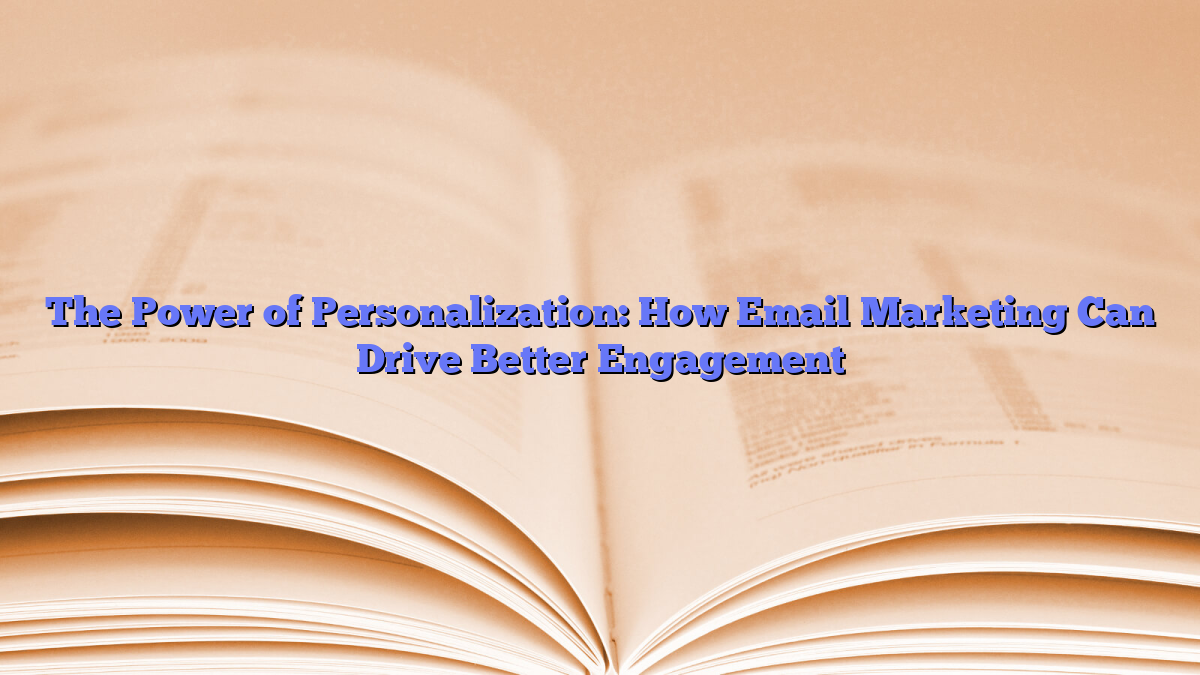Digital Marketing
The Power of Personalization: How Email Marketing Can Drive Better Engagement
Email marketing has proven to be an effective way for businesses to reach and engage with their target audience. However, in today’s digital age, consumers are inundated with countless emails on a daily basis. This makes it increasingly challenging for businesses to cut through the noise and capture the attention of their recipients.
One way to overcome this challenge is through the power of personalization. By tailoring your email marketing content to the individual preferences and behaviors of your audience, you can drive better engagement and ultimately improve the effectiveness of your email marketing campaigns.
This article will explore the importance of personalization in email marketing, along with strategies and best practices for leveraging personalization to drive better engagement.
The Importance of Personalization
Personalization in email marketing involves customizing the content of your emails to speak directly to the interests, needs, and preferences of each recipient. This can include using the recipient’s name in the subject line or body of the email, as well as tailoring the content based on their past interactions with your brand.
The importance of personalization in email marketing cannot be overstated. Research has shown that personalized emails receive higher open and click-through rates compared to generic, one-size-fits-all emails. This is because personalized emails are more relevant and resonate with recipients on a deeper level, making them more likely to engage with the content and take the desired action.
Strategies for Personalizing Email Marketing
There are several strategies and tactics that businesses can utilize to personalize their email marketing campaigns and drive better engagement. Some of these include:
- Segmentation: Divide your email list into smaller, more targeted segments based on demographics, behaviors, or preferences. This allows you to create more personalized and relevant content for each segment.
- Dynamic Content: Use dynamic content within your emails to deliver personalized recommendations, product suggestions, or tailored offers based on the recipient’s past interactions with your brand.
- Behavioral Triggers: Set up triggered emails that are automatically sent based on specific actions or behaviors, such as abandoned cart reminders or follow-up emails after a purchase.
- A/B Testing: Test different personalization elements, such as subject lines, content, or calls-to-action, to determine what resonates best with your audience and drives higher engagement.
Best Practices for Leveraging Personalization
In addition to the strategies mentioned above, there are several best practices that businesses should keep in mind when leveraging personalization in their email marketing efforts:
- Collect and Utilize Data: Gather as much data as possible about your audience, including their preferences, behaviors, and purchase history. Use this data to personalize your emails and create targeted content that resonates with each recipient.
- Keep it Relevant: Personalization should go beyond simply using the recipient’s name in the email. Ensure that the content and messaging are relevant to the recipient’s interests and needs, and provide value to them.
- Test and Optimize: Continuously test and optimize your personalization efforts to learn what works best for your audience. Use data and analytics to track the performance of your personalized emails and make adjustments accordingly.
Conclusion
In conclusion, the power of personalization in email marketing cannot be underestimated. By tailoring your email content to the individual preferences and behaviors of your audience, you can drive better engagement and ultimately improve the effectiveness of your email marketing campaigns.
Personalization allows you to create more relevant and targeted content that resonates with your recipients on a deeper level, leading to higher open and click-through rates, increased conversions, and improved customer loyalty.
By implementing segmentation, dynamic content, behavioral triggers, and A/B testing, and by following best practices such as collecting and utilizing data, keeping content relevant, and continuously testing and optimizing, businesses can harness the power of personalization to drive better engagement and achieve their email marketing goals.
FAQs
Q: How can I start implementing personalization in my email marketing campaigns?
A: Start by collecting relevant data about your audience, such as their preferences, behaviors, and purchase history. Use this data to segment your email list and create targeted content that resonates with each segment. You can also utilize dynamic content and behavioral triggers to deliver personalized recommendations and offers.
Q: What are some common mistakes to avoid when personalizing email marketing?
A: One common mistake is overpersonalization, where businesses use too much personal information in their emails, which can come off as intrusive. Another mistake is not testing and optimizing personalization efforts, leading to missed opportunities for improvement. It’s important to strike a balance and continuously refine your personalization strategy based on data and analytics.
[ad_2]
